| A Guide to Painting for Beginners |
 |
| When it comes to painting, it can seem overwhelming with all of its diversity. From different mediums, to different styles, as well as endless materials to even paint on! With the help of this article, painting will be broken down for you to understand. Including the different types of paints and what they do as well as helpful tips and tricks for beginners! Doing a small art project a week is the perfect way to spark the creative side as well as gain practice and build confidence.
Tips and Tricks for Beginners
- Use water based paints to start (i.e. acrylic, watercolour, gouache) as they do not require any toxic solvents!
- Use masking tape to create a boarder or block out any areas you don't want painted!
- Always create a light sketch as to not smudge the pencil!
- Starting off with a base wash ( a light watery base of paint that goes under the painting ) on the canvas can make painting less intimidating!
- Less is more! Always use less paint to start to avoid waste, as you can always get more.
- If possible, prop the canvas up so its facing you, that way you will get a proper perspective.
- Mixing white into the different colours creates more opaque paints!
- Use dark shades of blue or purple for shadows as black can be too harsh.
|
| Form, Content, Context |
 |
| One of the most important steps when it comes to painting is knowing how to break down and understand a painting, even before you begin creating one. The easiest way to break down any art medium is by understanding its Form, Content, and Context. The Form of an artwork is strictly what you see, including its lighting and shadows, contrast, colours, linework, medium, and size to name a few. The Content of an artwork is the story you see within the art, whether it be a scene of a garden at sunset or a child playing by the river. The Context is the back story; when it was made, how it affected its audience, and how its meaning has grown over time.
In simpler terms, Form is for the artist, Content is for the story tellers, and Context is for the history buffs. For example, looking at The Invasion (1892) by William-Adolphe Bouguereau, the Form is an oil painting composed mainly of cool colours such as greens and blues with stark contrasts and lighting focused upon the central figures. The Content of the image seen appears to be a half nude woman in a blue cloth surrounded by cherubs or cupids in the forest. The Context is that it was made in 1892 as a private aesthetic painting, strictly to visually appeal with no deeper meaning in its point in history. Also, it holds themes of classic Greek mythology as well as the idealization of the female form.
|
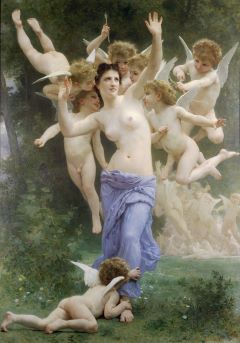
The Invasion (1892), William-Adolphe Bouguereau
|
| Painting Mediums |
 |
| The two main mediums of painting are oil and acrylic, with one being traditional and the other being more modernized. With acrylic paints being invented roughly in the 1950s and oil paints being used as early as the 7th century. Acrylic paint comes with many perks such as fast drying, even coating, base coat deemed unnecessary, adheres to any surface, and water soluble. Oil paints on the other hand have a flexible depth of colour as well as can be applied in thin and thick glazes. The biggest difference between the two is the drying times, with acrylic drying in roughly half an hour and oil drying in roughly 24 hours. This is neither good nor bad, just dependent on the painter themselves and their preferences.
Another popular painting medium is watercolour which is an easily blend-able transparent pigment that can be reactivated with water. A similar medium to this is gouache, with the primary difference being that gouache is more opaque than watercolour. These paints are perfect for creating dreamy pastel artworks and are easy to use as they can be reactivated with water, making the paint itself last a long time. However, these water paints can only be applied to certain papers and the paint can crack if too many layers are applied.
|
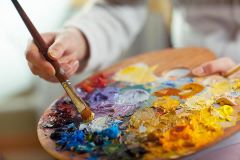
Oil and Acrylic Paints
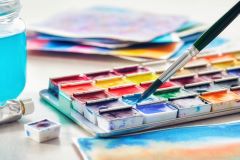
Watercolour Paints
|
| Benefits of Creating Art |
 |
| There are many benefits towards youth educational development through the arts. Through practicing art, young people will develop their learning in ways of thought, knowledge, expression, and feeling through the basis of creativity. As well, art can help build confidence within a young person. The skills learned through making art can result in an out of box thinking style and help with taking criticism and guidance from others. Art has many ties within other subjects such as math's, science, and history and can lead to a better understanding of all subjects when taught to think creatively. More benefits of art education can include a deepened understanding of culture as well as self, and improved cognition in the forms of verbal and visual memory, motor skills, and language communication. Overall, learning varying forms of art can lead to many personal growth benefits in young people as art has more power than just creativity.
|
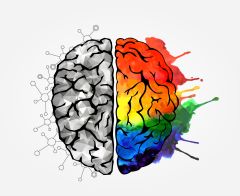
Creative Brain
|
| Overview |
 |
|
Painting can seem intimidating and tricky when you're a beginner however with practice and time you will see results! Understanding the difference between types of paint such as oil, acrylic, watercolour, and gouache is the first step in painting. With the help of the tips and tricks listed above, as well as the breakdown of Form, Content, and Context, you will have everything you need to know to get started. And with all the education benefits that come along with the practice of art, there is no reason to not want to become a painter! Like any art form, practice makes perfect!
|
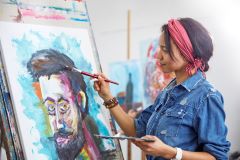
Painting Process
|
| Additional Resources |
 |
|
If you have questions about any of our services or products, don't hesitate to contact us. Our knowledgeable staff is always happy to assist with answers, advice, or suggestions.
|
|

|



|
USA Giclee On Canvas, Fine Art Printing - Art Scanning & Reproductions - Handmade Oil Paintings - Custom Wood Panels, Metal Picture Framing - Block/Plaque Mountings, Large Format Dry Mounting & Lamination - Art Supplies: Stretcher Bars, Cradled Wood Panels and Artist Canvas - Collages On Canvas - Plexi/Acrylic Face Mounts - Block Acrylics, Fabric Printing, Dye Sublimation - Cityscape Skyline Prints, Resin, Photo Gifts and more...
|
|
© 2002-2025 - KeenART Media Ltd.
|
|
| |
|
